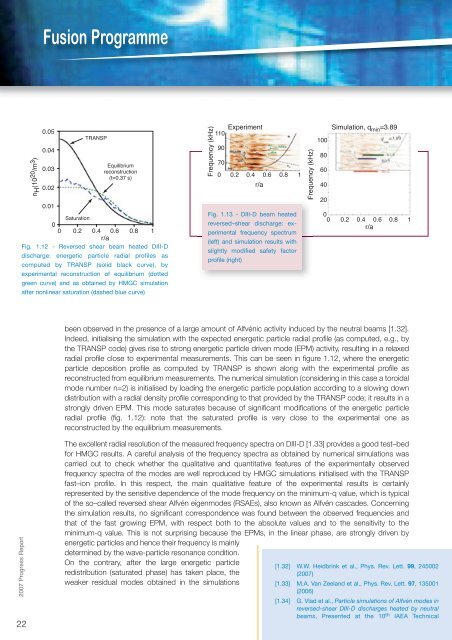Fusion Programme - ENEA - Fusione
Fusion Programme - ENEA - Fusione
Fusion Programme - ENEA - Fusione
- No tags were found...
You also want an ePaper? Increase the reach of your titles
YUMPU automatically turns print PDFs into web optimized ePapers that Google loves.
<strong>Fusion</strong> <strong>Programme</strong>n H (10 20 /m 3 )0.050.040.030.02TRANSPEquilibriumreconstruction(t=0.37 s)0.01Saturation00 0.2 0.4 0.6 0.8 1r/aFig. 1.12 - Reversed shear beam heated DIII-Ddischarge: energetic particle radial profiles ascomputed by TRANSP (solid black curve), byexperimental reconstruction of equilibrium (dottedgreen curve) and as obtained by HMGC simulationafter nonlinear saturation (dashed blue curve)Frequency (kHz)Experiment110Simulation, q min =3.891009080700 0.2 0.4 0.6 0.8 160r/aFig. 1.13 - DIII-D beam heatedreversed–shear discharge: ex -peri mental frequency spectrum(left) and simulation results withslightly modified safety factorprofile (right)Frequency (kHz)402000 0.2 0.4 0.6 0.8 1r/abeen observed in the presence of a large amount of Alfvénic activity induced by the neutral beams [1.32].Indeed, initialising the simulation with the expected energetic particle radial profile (as computed, e.g., bythe TRANSP code) gives rise to strong energetic particle driven mode (EPM) activity, resulting in a relaxedradial profile close to experimental measurements. This can be seen in figure 1.12, where the energeticparticle deposition profile as computed by TRANSP is shown along with the experimental profile asreconstructed from equilibrium measurements. The numerical simulation (considering in this case a toroidalmode number n=2) is initialised by loading the energetic particle population according to a slowing downdistribution with a radial density profile corresponding to that provided by the TRANSP code; it results in astrongly driven EPM. This mode saturates because of significant modifications of the energetic particleradial profile (fig. 1.12): note that the saturated profile is very close to the experimental one asreconstructed by the equilibrium measurements.2007 Progress Report22The excellent radial resolution of the measured frequency spectra on DIII-D [1.33] provides a good test–bedfor HMGC results. A careful analysis of the frequency spectra as obtained by numerical simulations wascarried out to check whether the qualitative and quantitative features of the experimentally observedfrequency spectra of the modes are well reproduced by HMGC simulations initialised with the TRANSPfast–ion profile. In this respect, the main qualitative feature of the experimental results is certainlyrepresented by the sensitive dependence of the mode frequency on the minimum-q value, which is typicalof the so–called reversed shear Alfvén eigenmodes (RSAEs), also known as Alfvén cascades. Concerningthe simulation results, no significant correspondence was found between the observed frequencies andthat of the fast growing EPM, with respect both to the absolute values and to the sensitivity to theminimum-q value. This is not surprising because the EPMs, in the linear phase, are strongly driven byenergetic particles and hence their frequency is mainlydetermined by the wave-particle resonance condition.On the contrary, after the large energetic particleredistribution (saturated phase) has taken place, theweaker residual modes obtained in the simulations[1.32] W.W. Heidbrink et al., Phys. Rev. Lett. 99, 245002(2007)[1.33] M.A. Van Zeeland et al., Phys. Rev. Lett. 97, 135001(2006)[1.34] G. Vlad et al., Particle simulations of Alfvén modes inreversed-shear DIII-D discharges heated by neutralbeams, Presented at the 10 th IAEA Technical













